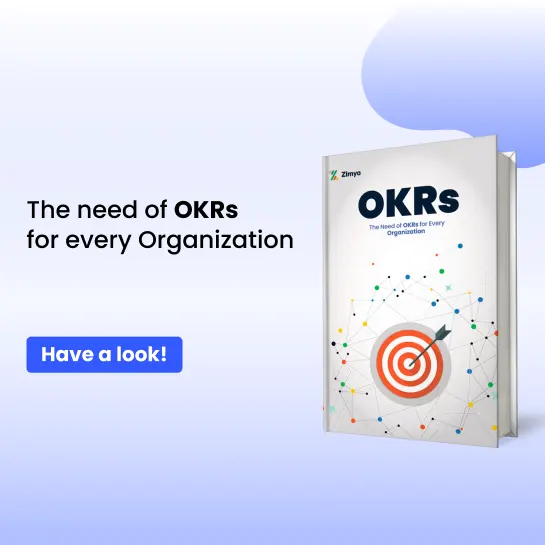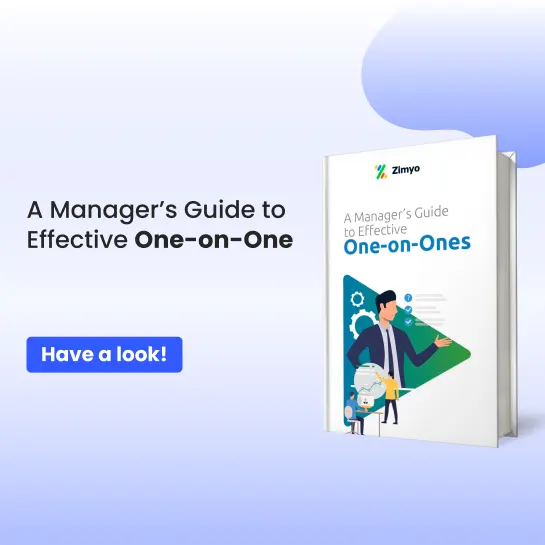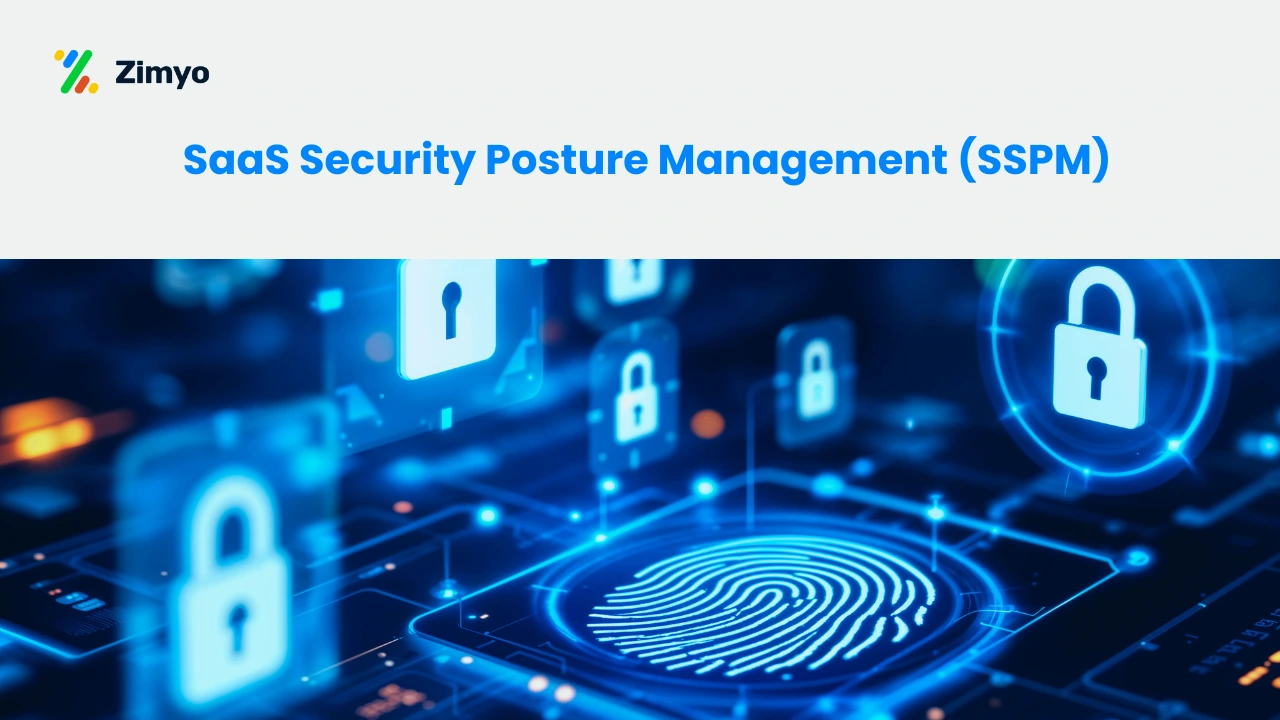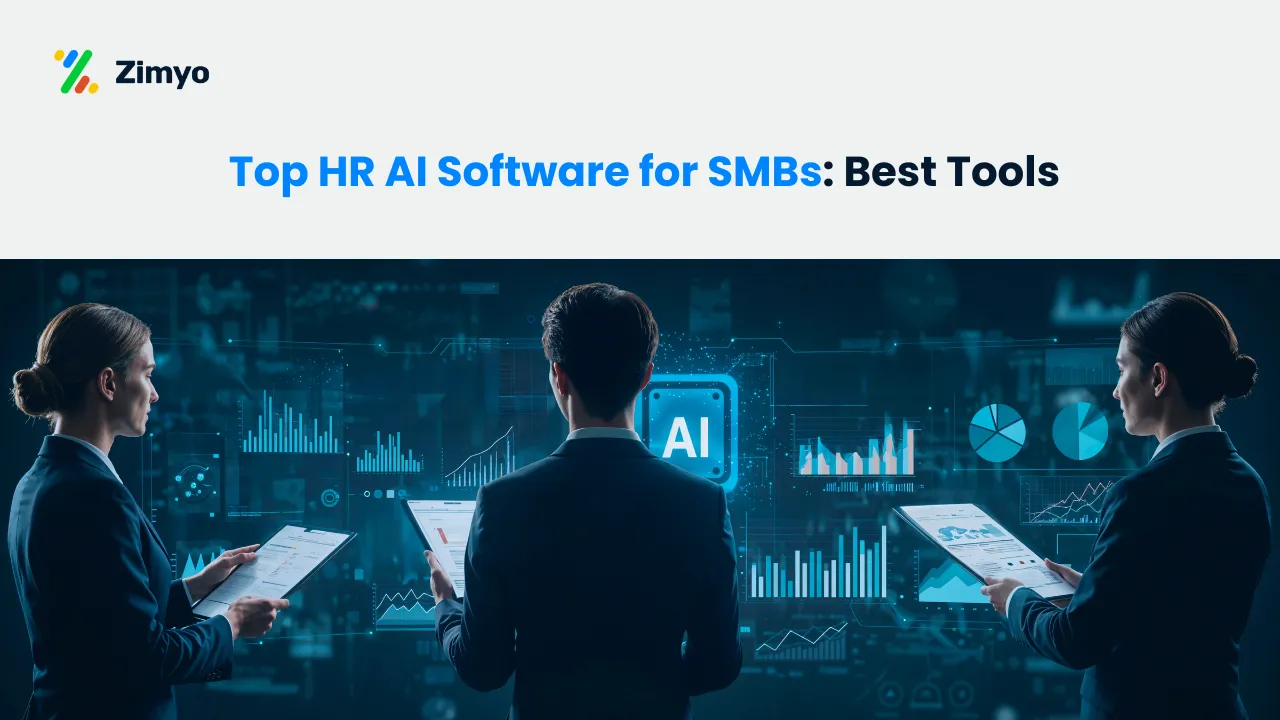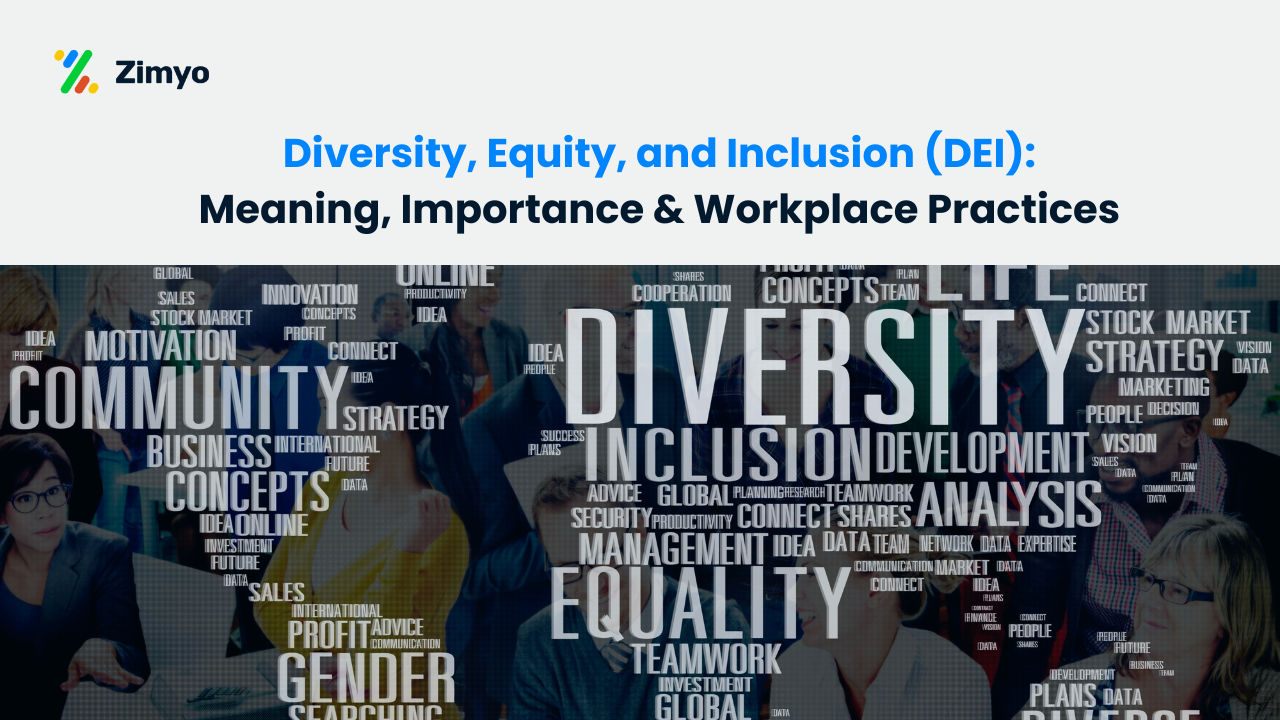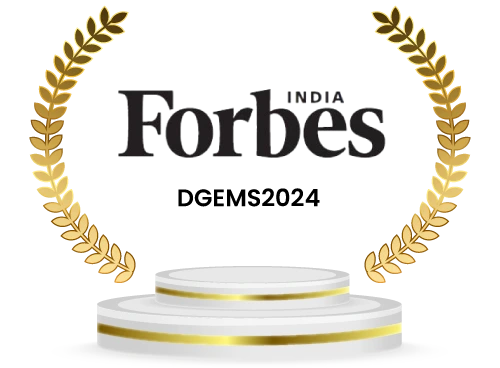Managing HR operations in a large company is difficult, a lot has to be managed than just payroll and attendance. Because big companies juggle with complex structures, global workforces (in case of MNC’s or cross-country hires), multiple locations, and ever-changing compliance demands according to these different geo locations. Which is why manual processes or outdated systems can cost millions in lost productivity, errors, and attrition.
And to overcome such high costs choosing best HR systems for large companies is essential, powerful platforms designed to streamline HR operations, engage employees, and drive business growth. In 2025, the best HR systems for large companies are tracking employees along with offering advanced analytics, HR automation, and seamless integrations.
What Is an HR System or HRIS?
Let’s understand the definition – An HR system, also known as an HRIS (Human Resources Information System), is a software that helps in managing employee data, HR processes, and compliance in an organization. In large enterprises, HRIS systems centralize information and automate workflows which ensures smooth collaboration across all departments.
You may also encounter terms like:
- HRMS (Human Resource Management System): It is Broader in scope including payroll and talent management
- HCM (Human Capital Management): It’s strategic focus is on workforce planning, analytics, and talent lifecycle
While often used interchangeably, all these systems share a common goal to help companies manage HR operations efficiently at scale.
Check Out Our Blog to Understand Difference Between HRMS vs HRIS vs HCM.
List of Best HR Systems For Large Companies (2025)
1. Zimyo
2. BambooHR
3. Rippling
4. Paycor
5. Deel, Inc.
6. Gusto
7. Paylocity
8. Workday
9. ADP
10. HiBob
11. Paychex
Best HR Systems for Large Companies in 2025: Detail
1. Zimyo
Zimyo is a powerful all-in-one HR software platform designed to cater to growing enterprises and large organizations. With its modern interface, automation-first design, and highly customizable modules, Zimyo helps businesses streamline everything from payroll and attendance to performance reviews and employee engagement. The platform is gaining traction globally among the best HR Systems for large companies for offering enterprise-level functionality at a competitive price point.
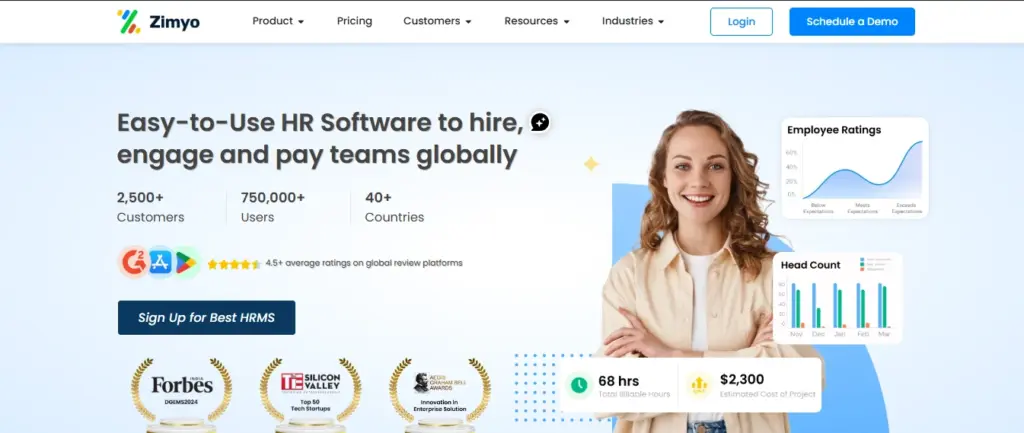
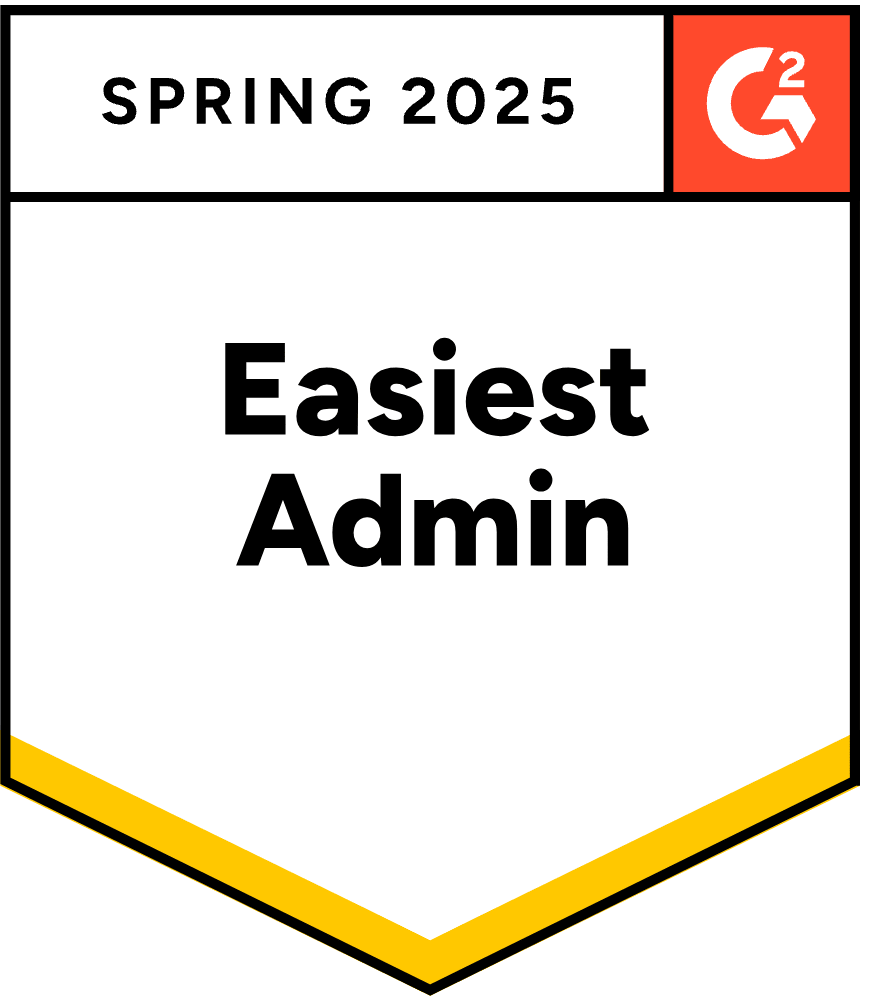
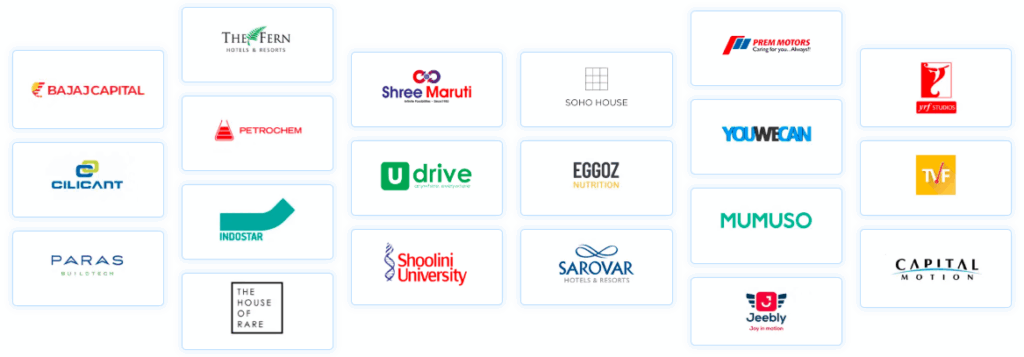
Zimyo's Key Features:
- Employee Management
- ESS Portal
- Time and Attendance
- Document Management
- Workflow Automation
- Travel Desk
- Applicant Tracking System
- Service Desk
- Analytics
- Payroll Automation
- Statutory Compliance
- Overtime Incentives
- Engage
- Feedback
- Recognition
- Learning Management System
- Timesheet
- Performance Management System
Pros:
- Highly customizable and scalable
- Excellent customer support
- Quick implementation
Cons:
- Lesser-known globally compared to giants like Workday
2. BambooHR
BambooHR is a popular human resource software tailored for small to mid-sized businesses but is scalable enough for large organizations. It focuses on delivering a user-friendly experience with intuitive design, making it a go-to for teams looking to digitize and streamline HR operations.
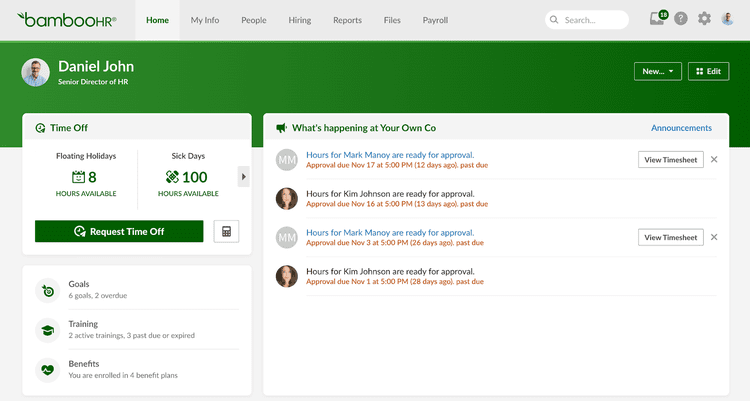
Key Features:
- Centralized employee database
- Time-off tracking
- Custom workflows and approvals
- Performance reviews
Pros:
- Clean, intuitive interface
- Great onboarding experience
- Strong ATS capabilities
Cons:
- Limited native payroll support (only for US)
3. Rippling
Rippling is an all-in-one platform that goes beyond HR and into IT, allowing large companies to manage employee data, payroll, benefits, and even devices from one dashboard. Its modular setup is especially appealing for fast-growing tech companies.
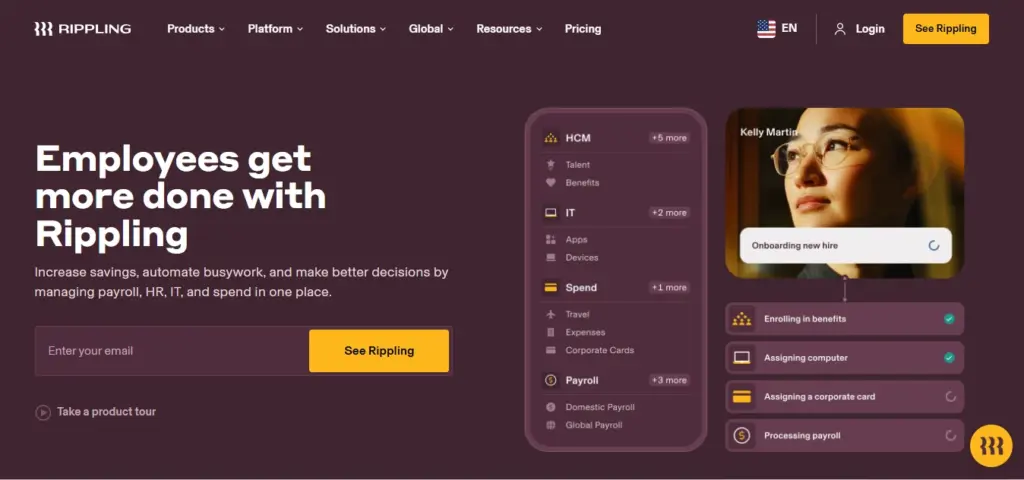
Key Features:
- Unified HR, IT, and finance management
- Global payroll and compliance
- Powerful reporting engine
- Automation workflows
- App provisioning and de-provisioning
Pros:
- Excellent automation capabilities
- Modular platform – pay only for what you use
Cons:
- Can get expensive with add-ons
4. Paycor
Paycor is built with mid-sized to large enterprises in mind, offering strong analytics and talent management tools. It’s particularly well-suited for companies that are looking to streamline recruitment, onboarding, and learning and development (L&D).
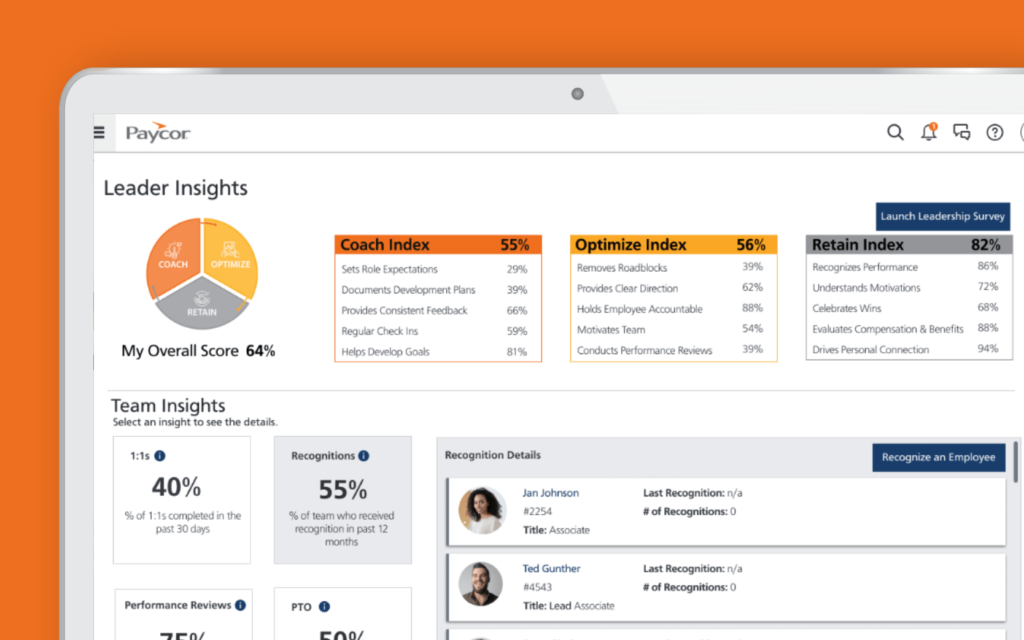
Key Features:
- Recruiting and onboarding suite
- Learning management system
- Performance tracking
- HR analytics dashboard
Pros:
- Robust L&D tools
- Excellent reporting and compliance
Cons:
- Interface can be overwhelming for new users
5. Deel, Inc.
Deel is a global payroll and compliance platform, perfect for large enterprises managing a remote or global workforce. It takes care of hiring, paying, and managing employees and contractors in over 150 countries.
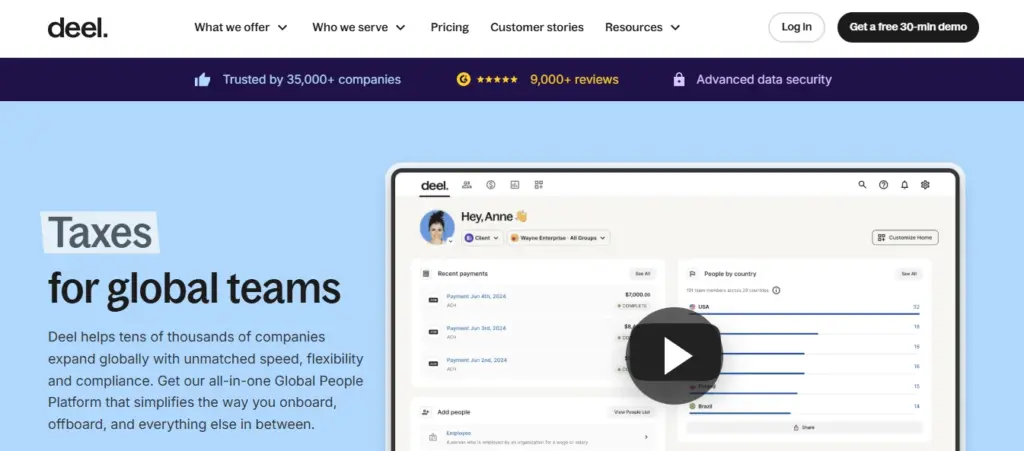
Key Features:
- Global payroll in 150+ countries
- Contractor management
- Tax and compliance automation
- EOR (Employer of Record) services
Pros:
- Ideal for global teams
- Fast onboarding across borders
Cons:
- Limited HRMS functionalities beyond payroll
6. Gusto
Gusto is known for its payroll and benefits administration, making it a favorite among US-based companies. While it started with small businesses, Gusto now offers functionality fit for large companies, especially for financial and HR compliance.
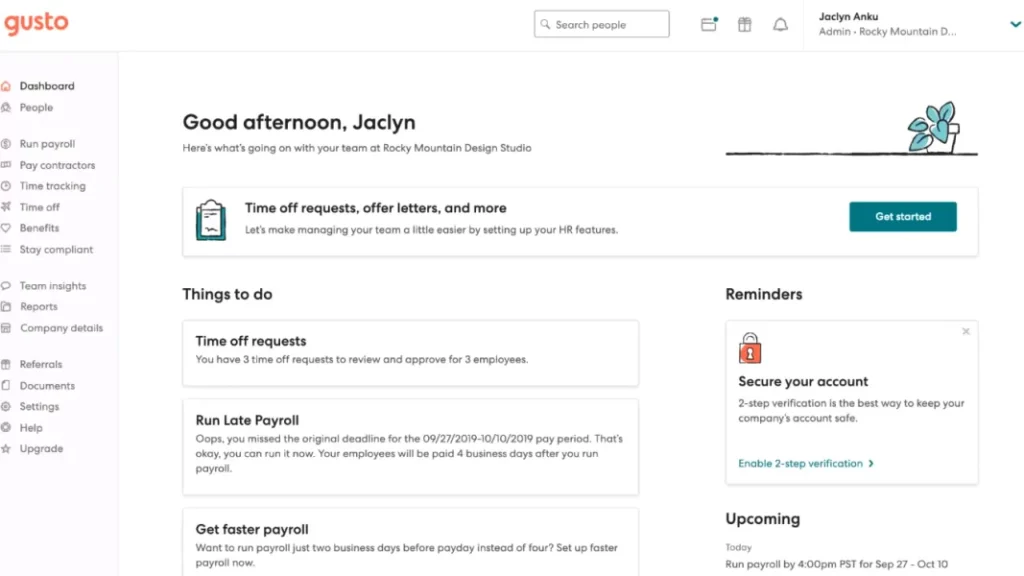
Key Features:
- Full-service payroll
- Benefits administration
- Time tracking
- HR tools for compliance and onboarding
Pros:
- Simple, clean interface
- Excellent support
Cons:
- Limited scalability for complex organizations
7. Paylocity
Paylocity provides a comprehensive HR and payroll solution with a focus on collaboration, employee engagement, and self-service features. It’s designed for large businesses that want an integrated platform.
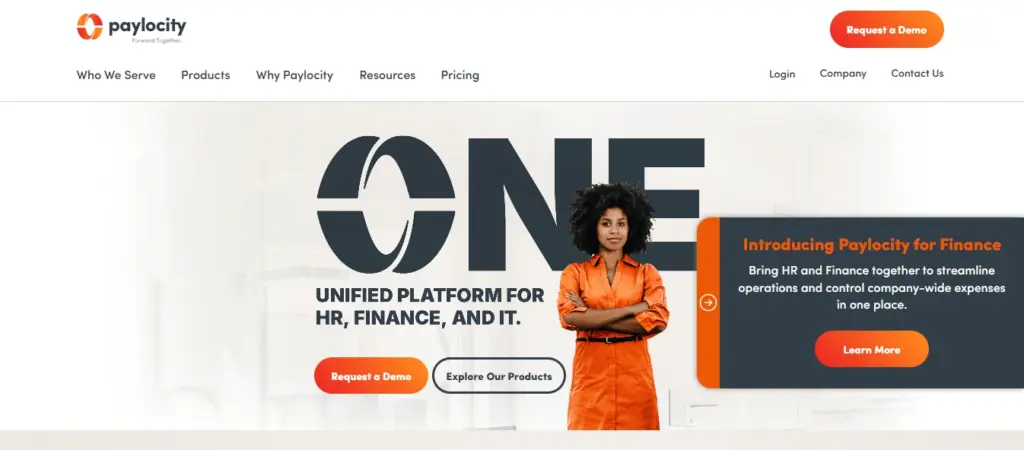
Key Features:
- Workforce management
- Time tracking & scheduling
- Performance & engagement tools
- Social collaboration features
Pros:
- Modern interface
- Strong analytics and dashboards
Cons:
- Onboarding experience could be better
8. Workday
Workday is one of the most advanced HCM systems globally. Built for enterprise-grade scalability, it offers modules covering everything from talent management to financial planning, making it a favorite among Fortune 500 companies.
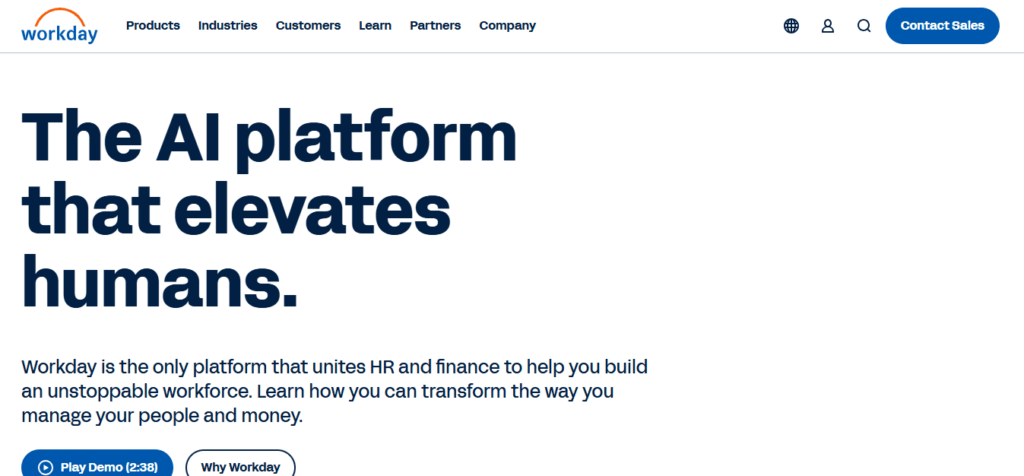
Key Features:
- Core HCM & finance
- Recruiting and onboarding
- Workforce planning
Pros:
- Highly scalable and configurable
- Trusted by global enterprises
Cons:
- High learning curve
- Expensive for mid-sized companies
9. ADP
ADP is a pioneer in payroll and human resource software with a reputation for reliability. With solutions tailored to businesses of all sizes, its enterprise solutions—like ADP Vantage HCM—are built for large companies with complex HR needs.

Key Features:
- Global payroll processing
- Benefits and talent management
- HR analytics
- Time and labor tracking
Pros:
- Excellent support and global coverage
- Strong payroll capabilities
Cons:
- Can feel outdated
10. HiBob
HiBob is a modern HR platform built to support organizational culture, performance, and engagement. It’s increasingly favored by large, fast-growing companies for its flexibility and people-centric approach.
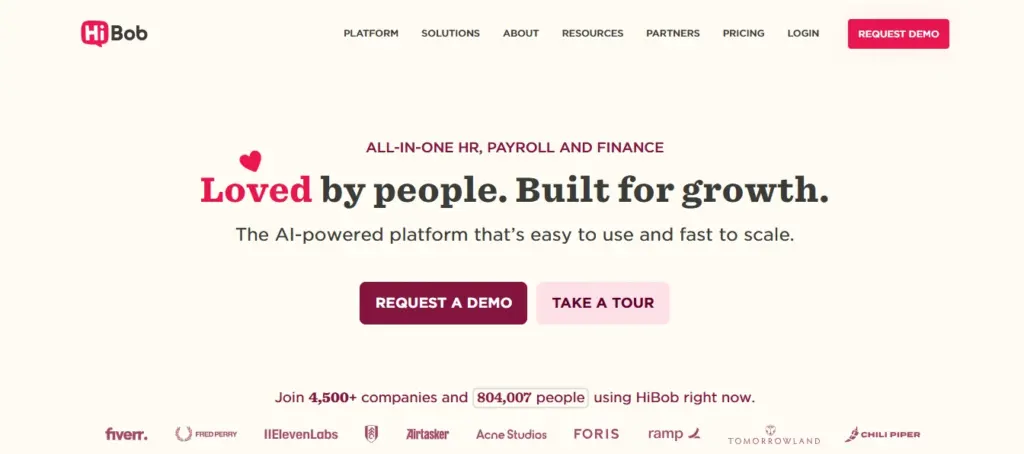
Key Features:
- Core HR & people analytics
- Onboarding and workflows
- Time-off management
- Culture and performance tracking
Pros:
- Fun, engaging interface
- Great people analytics tools
Cons:
- Limited native payroll support
11. Paychex
Paychex offers scalable HR, payroll, and benefits administration solutions. It’s a strong fit for large companies that need full-service HRIS systems with dedicated support and automation capabilities.
Key Features:
- Full-service payroll
- Employee benefits administration
- Time and attendance tracking
- Talent management tools
Pros:
- Strong support and compliance tools
- Scalable across company sizes
Cons:
- Dated interface compared to newer platforms
I was able to implement the platform on my own. It helps in assigning the tasks to other employees, conducting surveys and polls, and much more. The ease of use and self-onboarding is something that I would like to appreciate.
Sonali, Kommunicate
Zimyo simplifies attendance management for our organization. The leave and attendance are so streamlined that we have never faced any difficulties with the system.
Anurag, Eggoz Nutrition
Must-Have Features in an HR Software Solution
Picking an HR software is not just about picking up a top brand name, it goes deeper than that, to finding the right tools that meet your organization’s daily needs. If you’re managing a large global team or even maintaining local operations, here are the key features to look for in a modern HR system:
This employee self-service feature enables your staff to update personal details, view pay slips, apply for leaves, and access policy documents, all without having to ping HR every time. This not only saves time but increases transparency, and boosts employee engagement.
2. Global Payroll & Compliance
This is especially important for MNCs. HRIS systems simplify payroll by automatically calculating salaries, taxes, deductions, bonuses, and direct deposits. Having a solid payroll module minimizes errors, ensures timely payments, and keeps your team happy and compliant.
3. Smart Recruitment & Applicant Tracking
A modern HRIS system should be able to support the full hiring journey from posting the job ads and screening resumes to scheduling interviews and to sending offer letters. Bonus points if it offers automated onboarding workflows that save your team from endless admin work.
4. Advanced Reporting & Analytics
Data is the new oil especially if you’re looking for the best HR systems for large companies, from attrition rates to performance. Make sure your software provides detailed reports on workforce trends, turnover rates, time-to-hire, performance metrics, and more. These insights will help your HR team make smarter, strategic decisions.
5. Compliance & Risk Management Tools
Navigating labor laws can be a bit tricky, especially when working in multiple locations. Carefully choose software that helps monitor working hours, calculates taxes accurately, manages statutory filings, and alerts you of any compliance risks before they become legal headaches.
6. Time & Attendance Tracking
This feature allows you to track who’s working, when, and for how long. It accounts from logging hours, overtime to managing shift swaps and late check-ins, time-tracking features help HR stay on top of productivity and ensure accurate payroll.
7. Leave & Holiday Management
It is separate from attendance tracking, leave management allow employees to request time off, view remaining leave balances and get approvals – all within a few clicks, some tools may offer this within the ESS. These features help maintain clarity and reduce manual back-and-forth.
8. Talent & Performance Management
Upskilling and nurturing talent is key to organizational growth we all understand. So, Opt for an HR management system that supports goal setting, performance reviews, continuous feedback, and offers learning management.
9. End-to-End Employee Lifecycle Management
From hire to retirement, a very common phrase used by HR software companies. But actually, few deliver on that– human resource software that handles the entire employee journey. Features that support recruitment, onboarding, engagement, career progression, and smooth offboarding are cruciaal for maintaining a positive work environment.
10. Integrations with Other Tools
The best Human resource software don’t work in isolation, they usually have integration with ERP, ATS, accounting, and communication tools. Make sure your platform can integrate with email services, payroll systems, calendar apps, job boards, collaboration tools, and project management platforms. Seamless integration of different tools prevents you from falling in data silos and boosts efficiency.
Comparison Table: Best HR Systems for Large Companies
HR System | Best For | Global Payroll | Compliance | Performance Tools |
Zimyo | Compliance & engagement (India) | ✔️ | ✔️ | ✔️ |
BambooHR | Clean UI & onboarding | ❌ | ⚠️ (US-focused) | ✔️ |
Rippling | HR + IT automation | ✔️ | ✔️ | ✔️ |
Paycor | Full-suite HR & analytics | ✔️ | ✔️ | ✔️ |
Deel | International hiring | ✔️ | ✔️ | Not specified |
Gusto | US payroll focus | ❌ | ✔️ | ✔️ |
Paylocity | Analytics & LMS | ✔️ | ✔️ | ✔️ |
Workday | Enterprise-grade HCM | ✔️ | ✔️ | ✔️ |
ADP | Payroll leader | ✔️ | ✔️ | ✔️ |
HiBob | Modern engagement | ✔️ | Not specified | ✔️ |
Paychex | US-based HR outsourcing | ✔️ | ✔️ | Not specified |
How to Select the Right HR Systems for Your Enterprise (Step–By–Step Guide)
From handling compliance headaches to optimizing payroll and employee engagement, here’s a smart framework to guide your decision-making process:
1. Identifying Core HR Pain Points
Start by pinpointing the specific HR challenges your team is facing. Understanding these pain points will help you shortlist software that provides the right solutions for your challenges. Some common issues you might be facing may include:
- Managing of international payroll and ensuring local currency payouts
- Understanding tax and labor laws across multiple regions
- Automating repetitive HR tasks to save time and reduce errors
- Integration of your current tools to eliminate redundant data entry
- Allowing employees to update personal details on their own through ESS to reduce HR admin load
Being clear about your hurdles helps you prioritize and pick a software with must-have features for your organizational growth.
2. Define Your Success and Establish Metrics
Outlining the goals you want to achieve with your HR software and how you plan to measure them will allow you to access outcomes and not just focus on product features. Some suggested performance indicators may include:
- How much time is saved by HR staff due to self-service capabilities
- How much improvement is there in employee engagement and satisfaction
- Does it provide faster recruitment and onboarding timelines
- Is it giving higher completion rates for mandatory training programs
By locking in your metrics, you are ensuring that you are investing in a solution that drives real business value.
3. Mapping Out Your User Profiles
Different user groups are going to interact with the system in different ways. Make sure the solution supports the daily workflows of:
- HR heads and operations leaders
- HR executives managing payroll, hiring, or compliance
- Finance and accounting teams (CFOs, payroll processors)
- Departmental managers and team leads
- Regular employees accessing self-service dashboards
Evaluating each group’s needs helps you choose a user-friendly system that scales across departments.
4. Estimate a Realistic Budget
Most HR software platforms operate on a per-employee, per-month pricing model but still it is better to inquire from the official source. To pre-calculate your expenses, calculate your current team size and consider projected employee growth for at least over the next 3-5 years.
Important Note – Make sure to factor in not just subscription fees, but also costs related to onboarding, integrations, support, and upgrades.
5. List out Required Integrations
Ask yourself based on the requirement: Will this new system replace multiple tools, or does it need to integrate with existing software?
Common integrations to look for include:
- Payroll processing tools
- Time tracking systems
- Accounting and finance platforms
- Communication and collaboration tools (e.g., Slack, Teams, Gmail)
You might want to explore whether the platform supports custom integrations through APIs or third-party connectors. Which is crucial if your organization uses specialized tools or workflows.
6. Check Technical Compatibility and Security
Your chosen HR software should fit smoothly within your current tech ecosystem. Run a compatibility check on:
- Whether it works with your productivity suite (e.g., Microsoft 365, Google Workspace)
- Is capable in meeting your data security standards (e.g., 2FA, data encryption, compliance certifications)
- Or whether it can accommodates remote or hybrid work settings
Security, scalability, and adaptability are essential, especially for growing enterprises managing large teams and sensitive data.
Benefits of using Best HR Software for Large Companies
The best HR systems for large companies are designed to transform your HR functions by simplifying, automating, and enhancing your human resource management operations. Here are the key benefits of adopting an HR software:
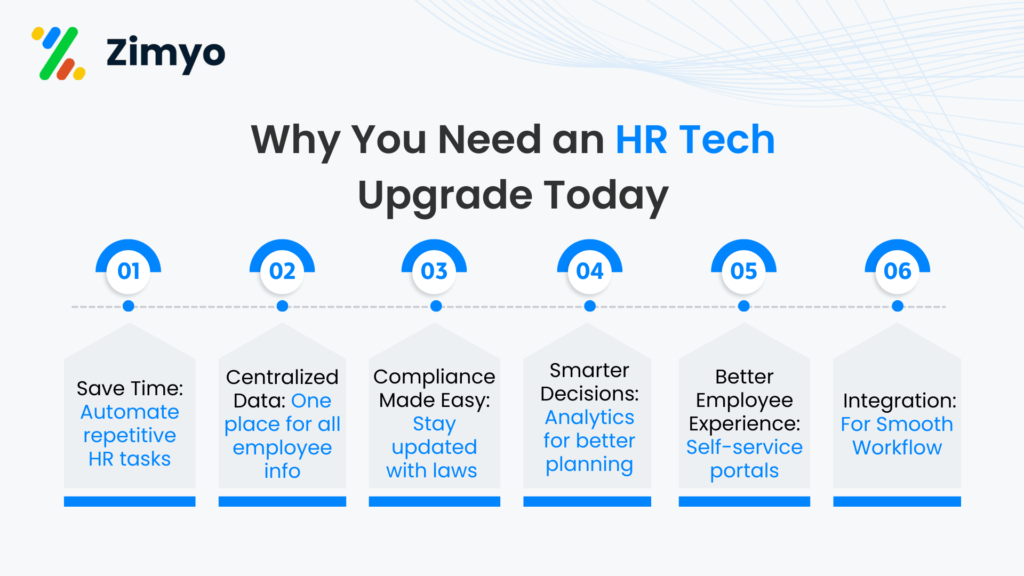
1. Improved Efficiency
HR systems automate repetitive tasks such as payroll processing, leave approvals, and document generation which allows HR to focus on other strategies like employee development and retention.
2. Centralized & Streamlined Data Management
HR system reduces paper records and spreadsheet keeping by storing all employee data in a centralized digital platform. scattered spreadsheets. It ensures that data is updated in real-time, securely stored, and accessible to authorized personnel, improving overall accuracy and efficiency.
3. Improved Legal & Regulatory Compliance
HR software stays updated with the latest labor laws and compliance requirements. Features such as audit trails, automated compliance alerts, and built-in policy updates help companies minimize the risk of legal penalties and maintain a compliant workforce.
4. Data-Driven Decision Making
Advanced reporting and analytics tools allow HR leaders to monitor workforce performance, identify trends, and make informed decisions. Whether it’s turnover rates, recruitment effectiveness, or attendance patterns, HR software helps in translating data into strategic business actions.
5. Enhanced Employee Experience & Self-Service
Self-service portals allow employees to manage their own profiles, submit leave requests, download payslips, and track their performance goals. This gives a sense of autonomy fostering a sense of ownership among employees, boosts transparency, and also improves employee satisfaction.
6. Better Talent Management
From recruitment to retirement, a well-designed HR system supports the full employee lifecycle. Modules for onboarding, performance reviews, training, and succession planning ensure your workforce is engaged and aligned with business goals.
7. Improved Collaboration and Internal Communication
Many HR tools include built-in messaging systems, document sharing, and task assignment features. These functions improve team collaboration and streamline communication across departments.
8. Integration with Existing Business Tools
Know that best HR systems for large companies always integrate smoothly with other business tools like accounting software, project management apps, email platforms, maintaining a smooth digital workflow across your organization.
Final Thoughts
In the end finalizing the best HR systems for large companies is a decision that can shape their entire workforce experience. It’s not only about flashy features or big names but about finding the right solution that truly matches with your business goals, grows with your workforce, supports compliance across regions, and is easy to use creating a smooth user experience.
So, whether you’re considering market dominant tools like Workday and ADP or exploring newer, agile platforms like Zimyo and Rippling, there is no one-size-fits-all answer. It all depends on what fits best for your team and organization. So it is always wise to take advantage of demos and trials to understand a platforms suitability before making your final call.
FAQs
Which HCM is best for large companies?
Workday is widely regarded as the top HCM for large enterprises due to its scalability, global compliance, and advanced analytics.
What are the three top HRIS systems?
Top 3 HRIS systems are Zimyo, Workday, and ADP offering comprehensive HR features for businesses of all sizes.
What is the best HR system?
The best HR system varies by need, but Zimyo, Workday, and ADP are top choices for enterprise-level HR management.
What are the 5 types of HRIS?
Operational – Handles day-to-day HR tasks
Tactical – Supports hiring and training
Strategic – Aids in long-term planning
Comprehensive – All-in-one HR suite
Limited-function – Focused on specific tasks

